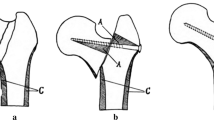Summary
The optimal degree of rigidity of internal fixation of fractures is still a matter of controversy. Since any attempt to clarify this situation must rest on a clear terminology, we propose terms relating to different degrees of rigidity. They are based on the material and the design of implants as well as the morphologic features of repair. From our morphologic findings it is obvious that the healing response and the subsequent structural remodelling depend on bone deformation and gap motion. Clinical significance: For sound patient care, the most ideal mode of internal fixation by plates, yielding rapid and efficient fracture healing, has to be established scientifically in a comparative study.
Zusammenfassung
Die Frage der optimalen Steifigkeit einer internen Fixation von Frakturen ist immer noch unentschieden. Da jeglicher Versuch einer Klärung dieser Frage von einer klaren Definition der Fachausdrücke abhängt, schlagen wir Ausdrücke vor, die die verschiedenen Steifigkeitsgrade widerspiegeln. Diese stützen sich auf Materialeigenschaften und Formen der Implantate sowie auf die morphologischen Bilder der Heilung. Unsere histologischen Auswertungen beweisen, daß der Heilungsprozeß und die daran anschließende strukturelle Remodellierung von Knochendeformation und Spaltbewegung abhängen. Klinische Bedeutung: Im Interesse einer bestmöglichen Versorgung sollte die Art einer internen Plattenfixation, die die rascheste und komplikationsfreieste Heilung herbeiführt, durch wissenschaftlich einwandfreie Vergleichsuntersuchungen bewiesen werden.
Similar content being viewed by others
References
Burny F, Bourgois R, Donkerwolcke M (1980) The elastic fixation of fractures. In: Uhthoff HK (ed) Current concepts of internal fixation of fractures. Springer, Berlin Heidelberg New York, pp 430–442
Müller ME, Allgöwer A, Schneider R, Willenegger H (1979) Manual of internal fixation, 2nd edn. Springer, Berlin Heidelberg New York
Tayton K, Johnson-Nurse C, McKibbin B, Bradley J, Hastings G (1982) The use of semi-rigid carbon fibre reinforced plastic plates for fixation of human fractures. J Bone Joint Surg [Br] 64:105–111
Uhthoff HK, Bardos DI, Liskova-Kiar M (1981) The advantages of titanium alloy over stainless steel plates for the internal fixation of fractures. An experimental study in dogs. J Bone Joint Surg [Br] 63:427–434
Uhthoff HK, Finnegan MA (1983) The effects of metal plates on post-traumatic remodelling and bone mass. J Bone Joint Surg [Br] 65:66–71
Wirth CR, Campbell CJ, Askew MJ, Mow VC (1974) The biomechanical effects of compression plates applied to fracture. J Trauma 14:563–571
Author information
Authors and Affiliations
Rights and permissions
About this article
Cite this article
Uhthoff, H.K., Finnegan, M.A. The role of rigidity in fracture fixation. Arch. Orth. Traum. Surg. 102, 163–166 (1984). https://doi.org/10.1007/BF00575226
Received:
Issue Date:
DOI: https://doi.org/10.1007/BF00575226




